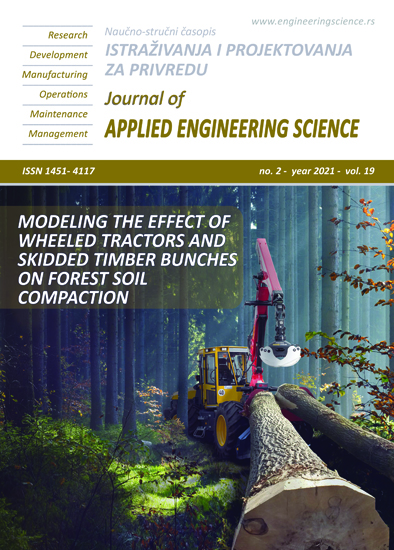EFFECT OF THE EMBER ELEMENT IN INCREASING THE EFFICIENCY OF LIQUEFIED PETROLEUM GAS STOVES
Abstract
The purpose of this study is to attempt to increase the efficiency of LPG stoves by using an ember element made of woven nickel wire arranged in layers. It is supposed that high-temperature embers can burn more fuel around the wire, thereby increasing the area of complete combustion. Testing was conducted by means of a Water Boiling Test (WBT) and the number of ember layers varied from one to four. It was found that the use of elements of fire without reflectors could increase efficiency by 8.32%, with the highest efficiency being with the use of a single layer ember element of the fire, of 61.71%. However, the use of elements of fire in the finned heat reflectors causes efficiency to decrease, as the pattern to put elements of fire interfere with the reflectivity. This means the heat reflection is blocked by the pattern and trapped between the reflector and pattern elements. As a result, the heat energy from the reflector reflection cannot be forwarded to the combustion zone. The test results also show that the temperature distribution from ember element use can increase the area of complete combustion.
References
Khan, M. Y., Saxena, A. (2013). Performance of LPG cooking stove using different design of burn¬er heads. International Journal of Engineering Re¬search & Technology (IJERT), vol. 2, no. 7, 656-659.
Wu, C.Y., Chen, K.H., Yang, S.Y. (2014). Experi¬mental study of porous metal burners for domestic stove applications. Energy Conversion and Man¬agement, vol. 77, 380-388, DOI: 10.1016/j.encon¬man.2013.10.002
Zhen, H. S., Leung, C. W., Wong, T. T. (2014). Im¬provement of domestic cooking flames by utiliz¬ing swirling flows. Fuel, vol. 119, 153–156, DOI: 10.1016/j.fuel.2013.11.025
Dongbin, Z., Jinsheng, L., Guangchuan, L., Yan, D., Gang, X., Lihua L. (2007). Effects on combustion of liquefied petroleum gas of porous ceramic doped with rare earth elements. Journal of Rare Earths, vol. 25, 212-215, DOI: 10.1016/S1002-0721(07)60472-4
Muthukumar, P., Shyamkumar, P.I. (2013). Devel¬opment of novel porous radiant burners for LPG cooking applications. Fuel, vol. 112, 562-566, DOI: 10.1016/j.fuel.2011.09.006
Mishra, N.K., Mishra, S.C., Muthukumar, P. (2015). Performance characterization of a medium-scale liquefied petroleum gas cooking stove with a two-layer porous radiant burner. Applied Thermal Engineering, vol. 89, 44-50, DOI: 10.1016/j.applther¬maleng.2015.05.077
Pantangi, V.K., Mishra, S.C., Muthukumar, P., Red¬dy, R. (2011). Studies on porous radiant burners for LPG (Liquefied Petroleum Gas) cooking appli¬cations. Energy, vol. 36, no. 10, 6074-6080, DOI: 10.1016/j.energy.2011.08.008
Mishra, N., K., Muthukumar, P. (2018). Development and testing of energy efficient and en¬vironment friendly porous radiant burner operating on liquefied petroleum gas. Applied Thermal Engi¬neering, vol. 129, 482–489, DOI: 10.1016/j.applther¬maleng.2017.10.068
Abdurrachim, Wardani, D., Yudi, T. (2009). Fuel sav¬er on household gas stoves. Jurnal Teknik Mesin, vol. 24 no. 1, 57-66.
Gohil, P., P., Channiwala, S., A. (2011). Experimen¬tal investigation of performance of conventional LPG cooking stove. Fundamental Journal Thermal Sci¬ence and Engineering, vol. 1, no. 1, 25-34.
Syahrial, M. (2012). High efficiency biogas-stove fuel performance by adding reflectors. Bachelor the¬sis, Institut Teknologi Sepuluh November, Indonesia.
Sudarno, Fadelan (2015). The Improvement of The Efficiency of LPG Stoves Using Finned Heat Radi¬ation Reflector. Jurnal Ilmiah Semesta Teknika, vol. 18, no. 1, 94–105.
Widodo, A. S. (2014). Radiation sheath for efficient use of energy in gas stoves. Jurnal Rekayasa Mesin, vol. 5 no. 3, 291–295.
Aisyah, L., Rulianto, D., Wibowo, C., S. (2015). Anal¬ysis of the Effect of Preheating System to Improve Efficiency in LPG-fuelled Small Industrial Burner. Energy Procedia, Vol. 65, 180-185, DOI: 10.1016/j. egypro.2015.01.055
World Bank, E., D. (1985). Test results on kerosene and others stoves for developing countries.
VITA, Volunteers in Technical Assistance, (1982). Testing the efficiency of woodburning cookstoves: international standards, Mt. Rainier, Maryland, USA.
EPA., PCIA., A. (2007). The water boiling test, Se¬ries: 4.2.2 (January), 1-86.
EPA., PCIA., A. (2014). The water boiling test, Se¬ries: 4.2.3 (March), 1-86.
L’Orange C., Defoort, M., Willson, B. (2012). Influ¬ence of testing parameters on biomass stove per¬formance and development of an increased testing protocol. Energy for Sustainable Development, vol. 16, no. 1, 3-12, DOI: 10.1016/j.esd.2011.10.008
Mac Carty, N., Still, D., Ogle, D. (2010). Fuel use and emissions performance of fifty cooking stoves in the laboratory and related benchmarks of perfor¬mance. Energy for Sustainable Development, vol. 14, no. 3, 161-171, DOI: 10.1016/j.esd.2010.06.002
Muthukumar, P., Anand, P., Sachdeva, P. (2011). Performance analysis of porous radiant burners used in LPG cooking stove. International Journal of Energy and Environment, vol. 2, no. 2, 367–374.
Kotb, A., Saad, H., (2017). Case study for co and counter swirling domestic burners. Case Stud¬ies in Thermal Engineering, vol. 11, 98–104, DOI: 10.1016/j.csite.2018.01.004

